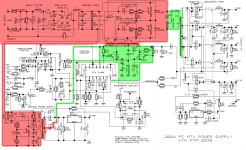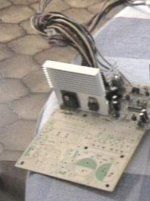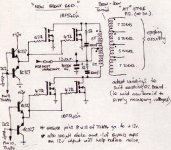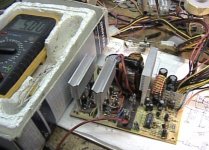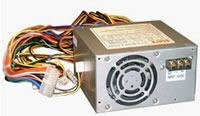razordave123 said:i need help my current project is installin a comp in a car and i wanna use the 110v without a power inverter because thats very ineffecient can somebody help me convert the input to 10-14v dc instead of 110-120v
You should not need to use any Mains 110V AC.
Standard Computer supply is +12 -12 +5 Volt.
You would need a converter from car battery, which is something like 12-13.8V.
Before starting, it is good to know how much current your PC will need
at the different voltage.
razordave123 said:now what i dont understand is that the psu converts 110 ac to dc so Id like to know if it converts to dc then splits up to the different voltages of dc or what in this case i should be able to remove the converter and just use the capacitors/resistors
?? What caps and resistors?? You will need a supply with a bunch of outputs. One supply(say the +ve) is easy enough and you could do say the +12, +5, +3.3 ect using linear regulators(LM350 ect). The difficult part is the -12, -5, -3.3. If you want efficiency your going to have to buy or make a pwm( pulse width modulated) supply. TL494 is a common pwm chip. Other key terms to search on are boost, buck and buck-boost. I believe you will need a buck or a buck-boost converter.
Such a PC power supply should have to provide 5V for standby even when off, and the conventional outputs: +5V, +12V, +3.3V, -5V, -12V, all cross-regulated. A power-good signal to inform the motherboard when the rails are settled at power-on and when input power has been just removed is also required.
This is not a simple project. Forget about linear regulators since that will provide very poor efficiency and a hard to manage amount of heat, particularly with modern CPUs above 1Ghz. Forget also about switching ICs if you want to take audio or video out of the PC and feed it to some car-multimedia system, this is because the PC ground must be floating for that and not connected to the car ground. A good option is to modify the primary side of a conventional ATX PC power supply, but this requires transformer rewinding and routing a new PCB, and you don't seemn to have the required knowledge and experience to do that.
So the more time and cost effective solution for you is probably to buy some 150W to 300W, 12V to 120V or 230V inverter and to power a conventional PC PSU with it. Note that AC is not even required since nearly all 230V PC PSUs work fine with DC (320V), and there are some simpler and smaller inverters, intended to power that kind of electronic gear, that output DC instead of AC.
This is not a simple project. Forget about linear regulators since that will provide very poor efficiency and a hard to manage amount of heat, particularly with modern CPUs above 1Ghz. Forget also about switching ICs if you want to take audio or video out of the PC and feed it to some car-multimedia system, this is because the PC ground must be floating for that and not connected to the car ground. A good option is to modify the primary side of a conventional ATX PC power supply, but this requires transformer rewinding and routing a new PCB, and you don't seemn to have the required knowledge and experience to do that.
So the more time and cost effective solution for you is probably to buy some 150W to 300W, 12V to 120V or 230V inverter and to power a conventional PC PSU with it. Note that AC is not even required since nearly all 230V PC PSUs work fine with DC (320V), and there are some simpler and smaller inverters, intended to power that kind of electronic gear, that output DC instead of AC.
As always, EVA hits the nail on the head. Tomorrow, I will post some pics of exactly what EVA describes as an extensive ATX modification from AC-DC to DC-DC.
Everything on the Primary (Hi Voltage DC) side is eliminated, and the transformer re-wound for 12V input, and the high voltage bipolars are exchanged for low voltage (55V) high current N-Channel MOSFETs. The dirver transformer is also re-wound. The kicker here is that for the main transformer, a toroid of the same material and power-handling capacity was substituted for the original E-I core.
Steve
Everything on the Primary (Hi Voltage DC) side is eliminated, and the transformer re-wound for 12V input, and the high voltage bipolars are exchanged for low voltage (55V) high current N-Channel MOSFETs. The dirver transformer is also re-wound. The kicker here is that for the main transformer, a toroid of the same material and power-handling capacity was substituted for the original E-I core.
Steve
I'm hoping to see these pictures 
There are special converters intended to power all those tiny ITX motherboards from 12V, and external power supplies that provide 12V from 120/230V AC mains. The following page shows some models:
http://www.mini-box.com/s.nl/sc.8/category.13/.f
Except two models, the rest connect the 12V rail of the motherboard directly to the 12V input, so they are not suitable at all to be used in a car because any minor input voltage drop will hang the computer, and the voltage surges commonly seen in cars when everything is turned off will blow the motherboard quickly.
The models intended for car use add regulation to the 12V line so they don't suffer from the previous pitfalls, but they still have a very big disadvantage: The ground of the computer is directly connected to the ground of the electrical system of the car. Due to ground loops, this will cause mild to serious sound and image interferences when video or audio from the computer is fed to external multimedia systems.
Also, as the PCBs reveal, all these power supplies suffer from a lack of EMI filters, that will ensure that plenty of RF noise is injected in the electrical system of the car and radiated (they take advantage of the fact that there are no EMI regulations inside a car). Furthermore, output filters are tiny (where are the capacitors? in fact, I bet they rely on the ones from the motherboard!!), and there is no pi-filtering, thus ensuring that the motherboard is fed with a lot of rippble in the supply rails. That ripple is very likely to get kindly returned to you in the analog sound and video outputs.
A conventional ATX power supply is way bigger, but it's cheaper and solves all the previously mentioned issues.
There are special converters intended to power all those tiny ITX motherboards from 12V, and external power supplies that provide 12V from 120/230V AC mains. The following page shows some models:
http://www.mini-box.com/s.nl/sc.8/category.13/.f
Except two models, the rest connect the 12V rail of the motherboard directly to the 12V input, so they are not suitable at all to be used in a car because any minor input voltage drop will hang the computer, and the voltage surges commonly seen in cars when everything is turned off will blow the motherboard quickly.
The models intended for car use add regulation to the 12V line so they don't suffer from the previous pitfalls, but they still have a very big disadvantage: The ground of the computer is directly connected to the ground of the electrical system of the car. Due to ground loops, this will cause mild to serious sound and image interferences when video or audio from the computer is fed to external multimedia systems.
Also, as the PCBs reveal, all these power supplies suffer from a lack of EMI filters, that will ensure that plenty of RF noise is injected in the electrical system of the car and radiated (they take advantage of the fact that there are no EMI regulations inside a car). Furthermore, output filters are tiny (where are the capacitors? in fact, I bet they rely on the ones from the motherboard!!), and there is no pi-filtering, thus ensuring that the motherboard is fed with a lot of rippble in the supply rails. That ripple is very likely to get kindly returned to you in the analog sound and video outputs.
A conventional ATX power supply is way bigger, but it's cheaper and solves all the previously mentioned issues.
Dc-dc Atx P4 Psu
Here is a thumbnail of a 250W 12V DC-DC ATX box I found somewhere in the internet- I don't remember where. I believe it has DC-DC ground isolation, too.
I believe it has DC-DC ground isolation, too.
I picked up a 300W DC-DC ATX PSU with 24V input last year on eBay for US$45.00. Of course, the very first thing I did was crack it open to see what is inside. The output section is pretty much the same as a standard line-powered ATX, but the 5VSB is on a separate board, with galvanic isolation. I believe it is either single-ended forward, or centertap push-pull. Need a further look......
Steve
Here is a thumbnail of a 250W 12V DC-DC ATX box I found somewhere in the internet- I don't remember where.
 I believe it has DC-DC ground isolation, too.
I believe it has DC-DC ground isolation, too.I picked up a 300W DC-DC ATX PSU with 24V input last year on eBay for US$45.00. Of course, the very first thing I did was crack it open to see what is inside. The output section is pretty much the same as a standard line-powered ATX, but the 5VSB is on a separate board, with galvanic isolation. I believe it is either single-ended forward, or centertap push-pull. Need a further look......
Steve
Attachments
- Status
- This old topic is closed. If you want to reopen this topic, contact a moderator using the "Report Post" button.
- Home
- Amplifiers
- Power Supplies
- 12v dc to dc 100w psu
